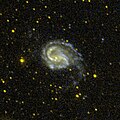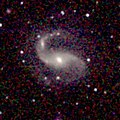| NGC 6907 | |
|---|---|
 NGC 6907 by Pan-STARRS | |
| Observation data (J2000 epoch) | |
| Constellation | Capricornus |
| Right ascension | 20h 25m 06.6s [1] |
| Declination | −24° 48′ 33″ [1] |
| Redshift | 0.010614 ± 0.000013 [1] |
| Heliocentric radial velocity | 3,182 ± 4 km/s [1] |
| Distance | 118 Mly (36.3 Mpc) [2] |
| Apparent magnitude (V) | 11.1 [3] |
| Characteristics | |
| Type | SB(s)bc [1] |
| Apparent size (V) | 3′.3 × 2′.7 [1] |
| Notable features | Luminous infrared galaxy |
| Other designations | |
| UGCA 418, ESO 528- G003, MCG -04-48-006, IRAS 20221-2458, PGC 64650 [1] | |
NGC 6907 is a spiral galaxy located in the constellation Capricornus. It is located at a distance of about 120 million light-years from Earth, which, given its apparent dimensions, means that NGC 6907 is about 115,000 light-years across. It was discovered by William Herschel on July 12, 1784. [4] The total infrared luminosity of the galaxy is 1011.03 L☉ , and thus it is categorised as a luminous infrared galaxy. [5]

